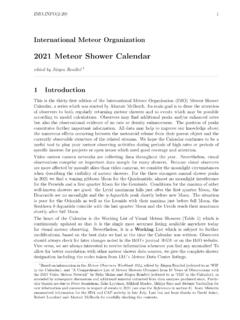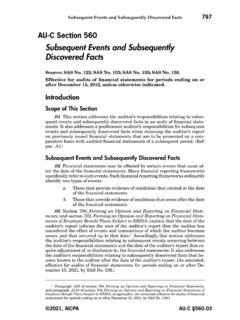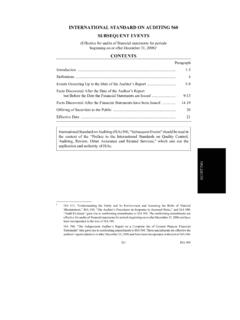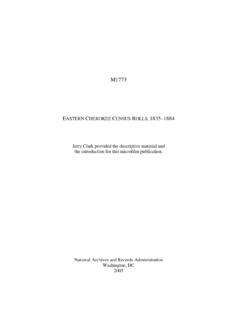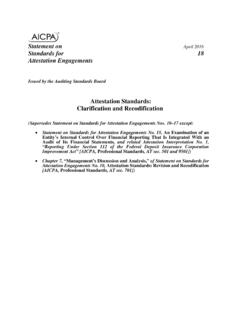Transcription of 2022 Meteor Shower Calendar
1 IMOINFO(3-21)1 International Meteor Organization2022 Meteor Shower Calendaredited by J urgen Rendtel11 IntroductionThis is the thirty-second edition of the International Meteor Organization (IMO) Meteor ShowerCalendar. Its main goal is to draw the attention of observers to both regularly returning meteorshowers and to events which may be possible according to model calculations. The publicationdate in the middle of the year was chosen to have the information spread early enough forinclusion into other may nd additional peaks and/or enhanced rates but also the observational evidence ofno rate or density enhancement. The position of peaks constitutes further important data may help to improve our knowledge about meteoroid streams.
2 We hope the Calendarcontinues to be a useful tool to plan your Meteor observing Meteor camera networks are collecting data throughout the year. Nevertheless, visualobservations comprise an important data sample for many showers. Because visual observersare more a ected by moonlit skies than video cameras, we consider the moonlight circumstanceswhen describing the visibility of Meteor showers. For the three strongest annual Shower peaks in2022 we nd moonless skies for the Quadrantids, almost full Moon for the Perseids and waninggibbous (near last quarter) Moon for the Geminids. Good conditions for the maxima of otherwell-known showers are found for the maximum period of the -Aquariids, Southern -AquariidsAurigids and the Ursids.
3 The Lyrid, Orionid and Leonid maxima fall in the period after the lastquarter Moon, and the October-Draconids occur at full heart of the Calendar is the Working List of Visual Meteor Showers (Table 5, page 25)which is continuously updated so that it is the single most accurate listing available anywheretoday for visual Meteor observing. Nevertheless, it is aWorkingList which is subject to furthermodi cations, based on the best data we had at the time the Calendar was written. Observersshould always check for later changes noted in the IMO's journalWGNor on the IMO versa, we are always interested to receive information whenever you nd any anomalies! Toallow for better correlation with other Meteor Shower data sources, we give the complete showerdesignation including the codes taken from IAU's Meteor Data Center on information in theMeteor Observers Workbook 2014, edited by J urgen Rendtel (referred to as `WB'in the Calendar ), and \A Comprehensive List of Meteor Showers Obtained from 10 Years of Observations withthe IMO Video Meteor Network" by Sirko Molau and J urgen Rendtel (referred to as `VID' in the Calendar ),as amended by subsequent discussions and additional material extracted from data analyses produced since.
4 Iparticularly thank Peter Jenniskens, Mikhail Maslov, Mikiya Sato and J er emie Vaubaillon for new informationand comments in respect of events in 2022 (see also theReferencesin section 8). Esko Lyytinen, who providedme with valuable hints and comments on predictions over many years, sadly passed away in December modelling results will keep him in our memory. Koen Miskotte summarised information for the SDA andCAP activity in late July. Last but not least thanks to Robert Lunsford, Alastair McBeath and Ina Rendtel forcarefully checking the (3-21)The available predictions for 2022 include a potential outburst of the Tau Herculids on May31, a Shower which is at or below the detection threshold at least for visual observers in otheryears.
5 Further very interesting encounters are listed in Table 6a (page 27). Since there is alwaysa possibility of completely unexpected events , ideally Meteor observing should be performedthroughout the year. This way we can improve the data for established meteoroid streamscovering their entire activity periods. Combining data obtained with di erent techniques improvethe reliability of derived quantities and is helpful for calibrating Meteor observations allow us to detect weak sources. An increasing number of con rmedradiants provides us with more possibilities to establish relations between meteoroid streamsand their parent objects. Some of the sources may produce only single events but no annualrecurring showers, such as, for example, the June Bootids and the October techniques which allow the collection of useful Shower data include visual, video andstill-imaging along with radar and radio forward scatter methods.
6 Visual and video data allowrate and ux density calculations as well as determination of the particle size distribution interms of the population indexror the mass indexs. Multi-station camera setups provide uswith orbital data, essential for meteoroid-stream investigations. Showers with radiants too nearthe Sun for observing by the various optical methods can be detected by forward-scatter radioor back-scatter radar observations { although attempts with optical observations can be usefultoo. Some of the showers are listed in Table 7, the Working List of Daytime Meteor IMO's aims are to encourage, collect, analyze, and publish combined Meteor data obtainedfrom sites all over the globe, to improve our understanding of the Meteor activity detectablefrom the Earth's surface.}
7 For best e ects, it is recommended that all observers should followthe standard IMO observing guidelines when compiling information, and submit those datapromptly to the appropriate Commission for analysis (contact details are at the end of theCalendar). Many analyses try to combine data obtained by more than one method, extendingthe ranges and coverage but also to calibrate results from di erent techniques. Thanks to thee orts of the many IMO observers worldwide since 1988 that have done this, we have been ableto achieve as much as we have to date, including keeping the Shower listings vibrant. This is nota matter for complacency however, since it is solely by the continued support of many peopleacross the planet that our attempts to construct a better and more complete picture of thenear-Earth meteoroid ux can predictions are included below on all the more active night-time and daytime showermaxima as reliably as possible.
8 However, it is essential to understand that in many cases, suchmaxima are not known more precisely than to the nearest degree of solar longitude. In addition,variations in individual showers from year to year mean past returns are only a guide as to wheneven major Shower peaks can be expected. As noted already, the information given here may beupdated and added-to after the Calendar has been published. Some showers are known to showparticle mass-sorting within their meteoroid streams, so the radar, radio, still-imaging, videoand visual Meteor maxima may occur at di erent times from one another, and not necessarilyjust in those showers. The majority of data available are for visual Shower maxima, so this mustbe borne in mind when employing other observing and whenever you are able to observe, we wish you all a most successful year's workand very much look forward to receiving your data, whose input is possible via the online formon the IMO's Clear skies!
9 IMOINFO(3-21)32 Antihelion SourceThe Antihelion Source (ANT) is a large, roughly oval area of about 30 in right ascensionand 15 in declination, centred about 12 east of the solar opposition point on the ecliptic,hence its name. It is not a true Shower at all (hence it has no IAU Shower number), but israther a region of sky in which a number of variably, if weakly, active minor showers have theirradiants. Until 2006, attempts were made to de ne speci c showers within this complex, butthis often proved very di cult for visual observers to achieve. IMO video results have shownthat even instrumentally, it was impossible to de ne distinct and constantly observable radiantsfor many of the showers here!
10 Thus we recommend observers simply to identify meteors fromthese streams as coming from the ANT alone. Apart from this, we have been able to retainthe -Capricornids and particularly the Southern -Aquariids in July to August as apparentlydistinguishable showers separate from the ANT. Later in the year, the Taurid showers dominatethe activity from the Antihelion region meaning the ANT should be considered inactive whilethe Taurids are underway, from early September into December. To assist observers, a set ofcharts showing the location for the ANT and any other nearby Shower radiants is included here,to complement the numerical positions of Table 6, while comments on the ANT's location andlikely activity are given in the quarterly summary January to MarchThe year starts with theQuadrantid (010 QUA)peak for the northern hemisphere observerson January 3 with no moonlight interference.
